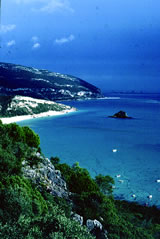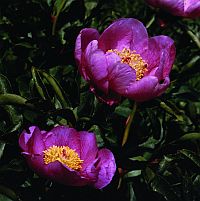 |
Serra da Arrábida, western Portugal
by Teresa Farino
A well-preserved enclave of Mediterranean forest in western Portugal, with a rich fauna and a superb limestone flora which includes several endemics.
 Arrábida Cliffs near Portinho
© Teresa Farino
Arrábida Cliffs near Portinho
© Teresa Farino
The forest-clad, elongated hummock of the Serra da Arrábida is a veritable oasis of natural
vegetation amid the suburban sprawl of the Setúbal peninsula, with an incredibly diverse wildlife
to match. Along the shore of the Sado estuary, its sheer flanks drop sharply into a turquoise
sea, the pale limestone cliffs eaten away at the base to form small sandy coves. Although the
50km-long ridge of the Arrábida attains a maximum of only 501m (Alto do Formosinho), the views
from the top are truly spectacular, giving the impression of much greater altitude.
Flora of the Serra da Arrábida
More than 1,000 species of vascular plants have been recorded from the Arrábida natural park
(10,821ha; also a reserva biogenética). Not long after Christmas, hoop-petticoat daffodils
(subspecies obesus) are out in force, accompanied by the curious friar's cowl, Barbary nut and
 Western Peony Paeonia broteri
© Teresa Farino
the sand crocus Romulea bulbocodium, to be joined by palmate anemone, rosy garlic, wild tulip
and the delicate green and purple bells of Fritillaria lusitanica when spring begins in earnest.
March brings a flush of orchids into bloom - champagne, conical, naked man, man and giant, plus
the insect-imitating dull, bumble-bee, yellow, mirror and sawfly ophrys - and come April, wild
and field gladioli and Spanish irises appear, together with pink butterfly, bug and tongue
orchids, while a search among the undergrowth should turn up the less conspicuous violet
limodore and two-leaved gennaria.
Western Peony Paeonia broteri
© Teresa Farino
the sand crocus Romulea bulbocodium, to be joined by palmate anemone, rosy garlic, wild tulip
and the delicate green and purple bells of Fritillaria lusitanica when spring begins in earnest.
March brings a flush of orchids into bloom - champagne, conical, naked man, man and giant, plus
the insect-imitating dull, bumble-bee, yellow, mirror and sawfly ophrys - and come April, wild
and field gladioli and Spanish irises appear, together with pink butterfly, bug and tongue
orchids, while a search among the undergrowth should turn up the less conspicuous violet
limodore and two-leaved gennaria.
A half-hour foray into the dense maquis flanking the N-379-1 which winds along the top of
the ridge will reveal an impressive list of typical Mediterranean shrubs: Phoenician juniper,
holly oak, lentisc, Mediterranean buckthorn, strawberry-tree, Osyris lanceolata, myrtle, shrubby
hare's-ear, Phillyrea angustifolia, P. latifolia, wild jasmine and laurustinus. The glossy
evergreen foliage is coloured by narrow-leaved and grey-leaved cistuses, tree heath, shrubby
scorpion-vetch, fringed rue, Phlomis purpurea and rosemary, with the whole mass inextricably
bound together by the twining stems of wild madder, Lonicera implexa and common smilax.
 Mirror Ophrys
Mirror Ophrys
Ophrys speculum
© Teresa Farino
Shady nooks along this road harbour Narcissus calcicola - the most renowned plant of the
Arrábida - found only in Portugal and neighbouring Badajoz in Spain.
On the seaward side of the ridge, the more humid climate and deeper soils of the valleys
which drop down to the coast support stands of Lusitanian oak (subspecies broteroi), bay, carob,
Montpellier maple and wild olive, with a characteristic spring-flowering ground layer of western
peony, Iberian milk-vetch, alexanders and Spanish bluebell. Three integral reserves have been
declared where the climax Lusitanian oak forest is more or less intact: Mata do Solitário, Mata
do Vidal and Mata Coberta, to which access is forbidden.
The sheer south-facing cliffs - accessible only via the trails down to the fishing villages -
boast their own peculiar flora, including the diminutive Portuguese endemic crucifers Arabis
sadina and Iberis procumbens ssp. microcarpa and more commonplace species such as sad stock,
sweet Alison, the Afro-Iberian endemic stonecrop Sedum mucizonia, fringed rue, mallow-leaved
bindweed and cut-leaved lavender, with shady nooks hosting Mediterranean selaginella and southern
polypody.
|